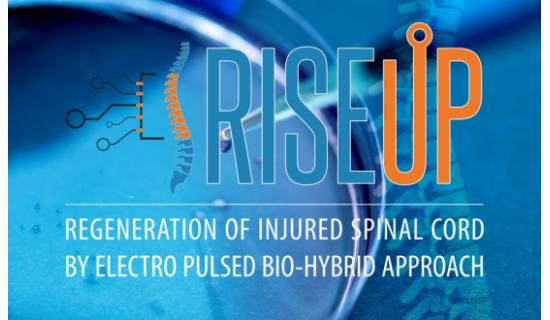Project RISEUP
Regeneration of injured spinal cord by electro pulsed bio-hybrid approach
Spinal Cord Injury (SCI), a major cause of paralysis, currently has no effective therapies. Every year almost 500.000 people are diagnosed with SCI worldwide.
The difficulty on the neuronal restoration after SCI is based on the complex cascade of events that inexorably cause a degenerative chronic stage mainly favored by the non-permissive environment and limited capacity for axonal regrowth. Multifaceted strategies are considered the unique solution for functional restoration by including cell substitution, neuroprotection and axonal growth promotion.
RISEUP proposes to attain neuronal functional regeneration after SCI by an unprecedented and unique bio-hybrid-compatible electro-activated and wireless-rechargeable implantable technology. RISEUP introduces high voltage microsecond electric pulses (micropulses) stimulations and low amplitude direct currents on a combination of stem cells (induced neural stem cells and multipotent stromal cells), whose transplantation is facilitated by an innovative scaffold biomaterial.
The RISEUP concept is that electric stimulations can induce stem cells neuronal differentiation and the scaffold can promote their transplantation in the lesioned tissue, making possible its regeneration.
RISEUP goal, even if ambitious, is concrete due to the multidisciplinary and considerable competences of the Consortium, which is constituted by, in addition to ENEA as Coordinator, Universitat Politècnica de València, RISE Technology Company, Sapienza University, CNRS, Centro Investigación Príncipe Felipe de València.
RISEUP aims at initiating a radically new line of technology (electro-activated, remotely controlled, biocompatible, biodegradable cell-containing implants for the repair of neuronal lesions), which, in a long-term vison, could lead to a radical change in SCI treatment.

